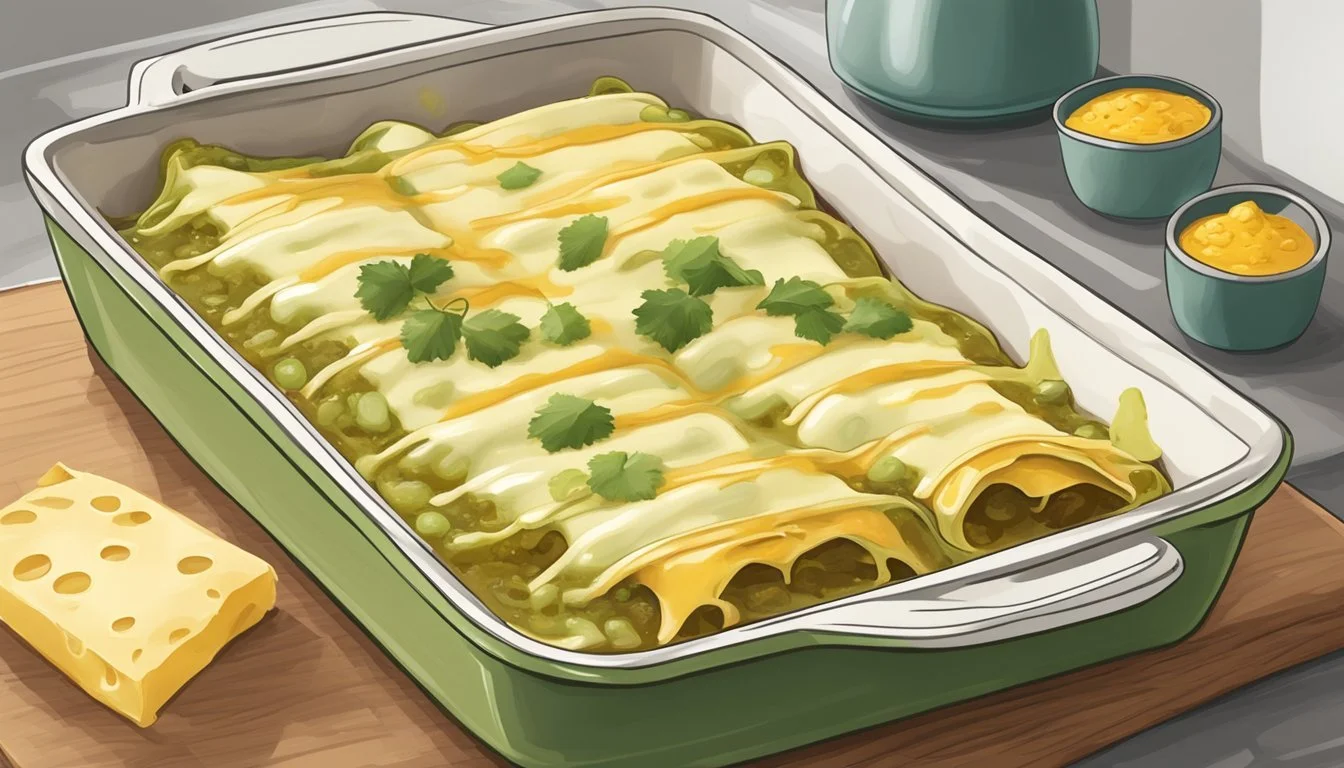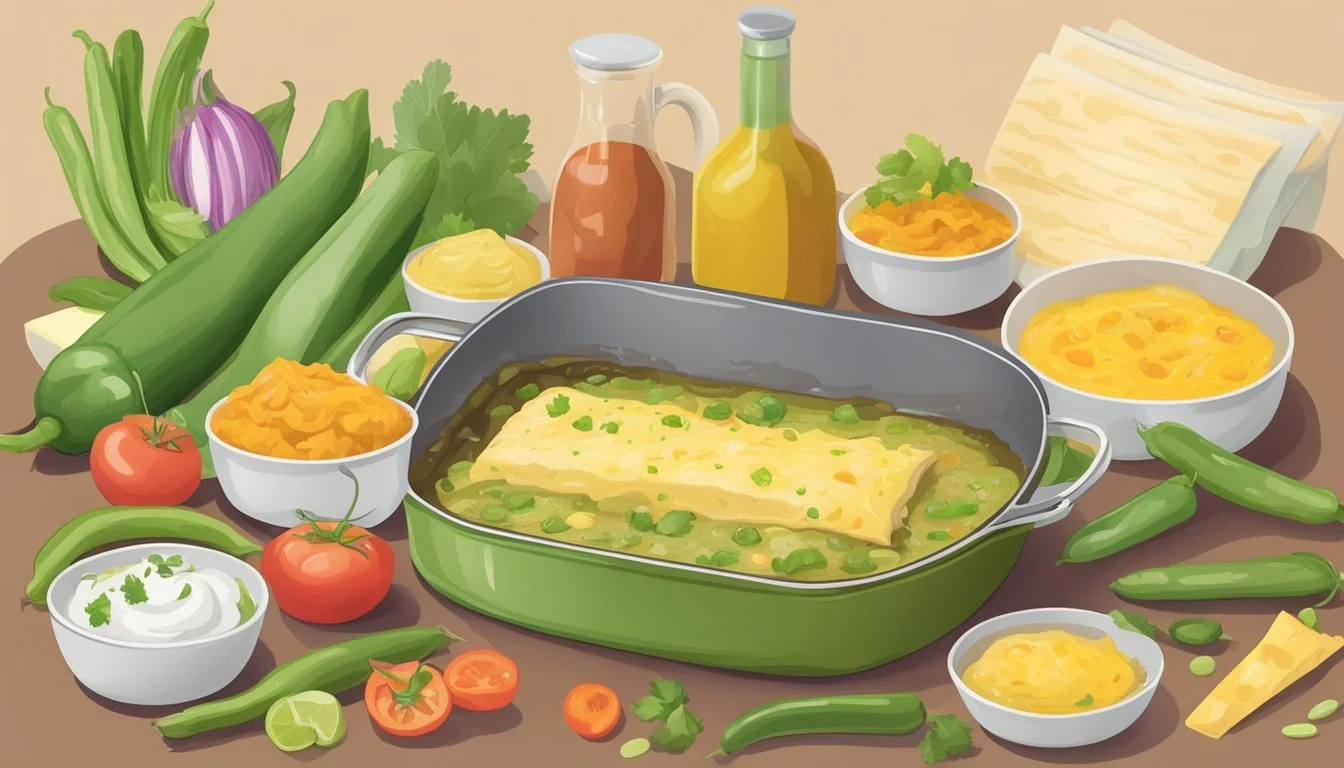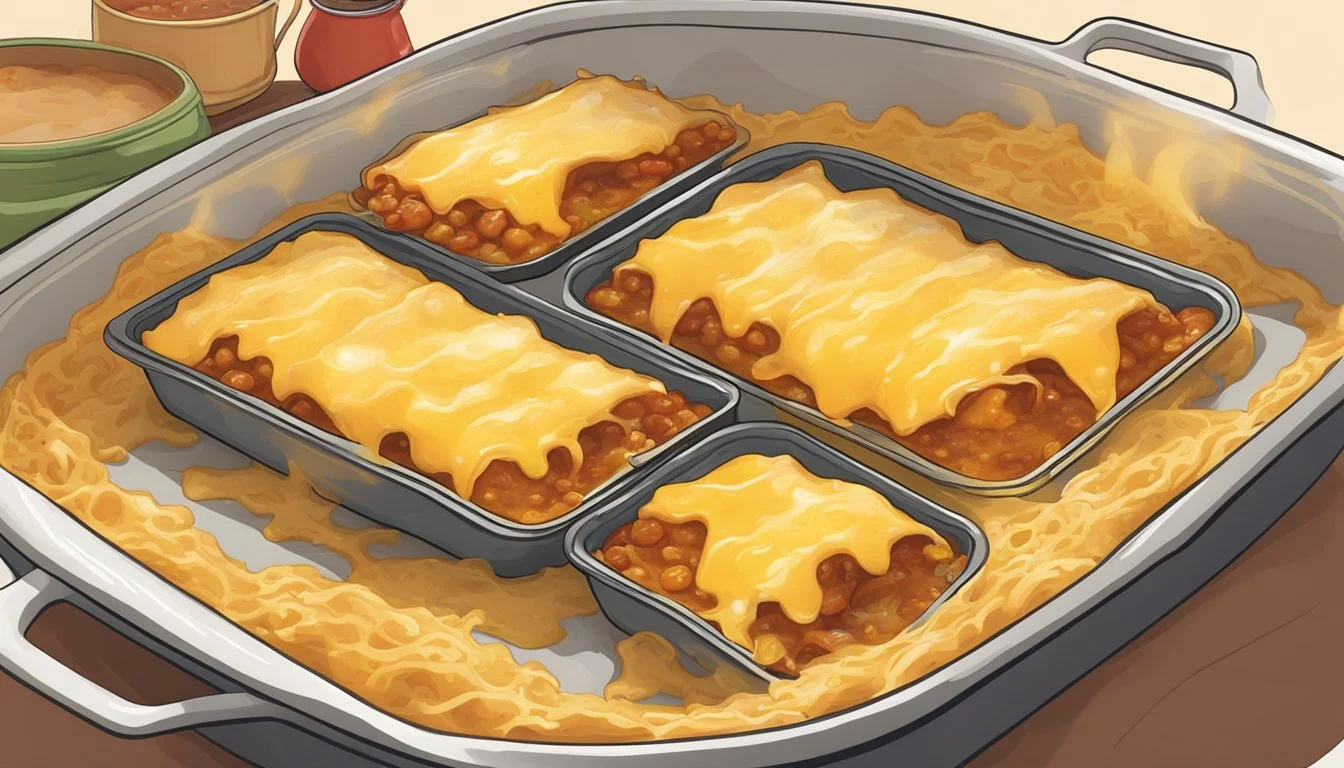Best Way to Reheat Green Chile Chicken Enchiladas
Keeping the Cheese Melty and Sauce Perfect
Ensuring that green chile chicken enchiladas retain their cheesy goodness and saucy texture during reheating requires a careful approach. The best methods preserve the delicate balance of flavors and textures that make enchiladas a beloved dish. When reheating chicken enchiladas, it’s important to maintain the integrity of the tortilla while ensuring that the cheese is sufficiently melted and the sauce envelops the dish in its original savory state.
Microwave reheating can seem convenient, but it often doesn't provide the best results for dishes like enchiladas where texture is paramount. However, if speed is of the essence, placing enchiladas on a microwave-safe plate, covering with a splatter guard, and heating on high for short intervals—rotating the dish halfway through—can lead to fairly even heating. To avoid sogginess, though, the oven is typically preferred. Heating the oven to 350 degrees Fahrenheit and warming the enchiladas until the cheese bubbles restores the original taste and texture without too much moisture loss.
For those who prefer a slightly crispier bottom and edges, a skillet can achieve this effect while also reinvigorating the cheese and enchilada sauce. A touch of oil in a hot skillet, and a careful few minutes on each side, can crisp the tortillas and revive the enchiladas’ exterior. This method adds a subtle char that can enhance the flavor profile of the enchiladas, while also ensuring the middle stays saucy and the cheese perfectly melted.
Understanding Enchiladas
Enchiladas are a traditional Mexican dish characterised by their rich flavors and satisfying textures. To comprehend their uniqueness, one must consider the essential components that forge this beloved meal.
Tortilla: The base of enchiladas, typically corn tortillas but sometimes flour, is soft yet firm enough to be rolled and stuffed with fillings.
Fillings: While the focus here is on green chile chicken, fillings can vary greatly from beef to beans. The chicken is often tender and seasoned, providing a hearty protein core.
Sauce: Essential to enchiladas is the green chile sauce, which imparts a tangy and sometimes spicy flavor profile.
Cheese: Generously sprinkled or layered, cheese adds a gooey and rich element, completing the dish.
Enchiladas are versatile:
Single Servings: They can be served individually, often accompanied by sides such as rice and beans.
Enchilada Casserole: Alternatively, they can be assembled in layers, much like a lasagna, to create an enchilada casserole.
When considering add-ons, sour cream is often a favored choice for its creamy and cooling complement to the zestful sauce. The proper integration of tortillas, chicken, cheese, and sour cream results in a harmonious balance between textures and flavors, making enchiladas a gratifying meal.
The construction and composition of enchiladas are pivotal to their distinct identity. When reheating, preserving the cheesiness and the integrity of the saucy component is critical to maintaining the essence of this classic dish.
Preparations Before Reheating
Ensuring green chile chicken enchiladas retain their cheesy goodness and saucy texture starts with proper storage. One must be meticulous in the preparations before reheating to guarantee the best possible outcome.
Storing for Freshness
Leftovers should be stored in an airtight container to maintain freshness and prevent other odors from infusing into the enchiladas. If one prefers, they may also wrap the enchiladas individually in plastic wrap and then in aluminum foil.
Refrigeration: Store enchiladas in the refrigerator if they are to be reheated within a few days.
Freezing: To freeze enchiladas, one should place them in a single layer to avoid any texture changes and then tightly cover them with foil.
Setting Up for Reheating
Before reheating, it's essential to set up properly for the most effective heat distribution.
Remove the enchiladas from the refrigerator and let them sit at room temperature for about 20 minutes. This minimizes thermal shock to the enchiladas and promotes even reheating.
Preheat the oven to the recommended temperature if using the oven method to ensure a crisp exterior and a warm, gooey interior.
By adhering to these steps, the enchiladas' texture and flavors will be optimally preserved during reheating.
Oven Reheating Method
Reheating green chile chicken enchiladas in the oven is a superior method to maintain their cheesy texture and saucy moisture. The oven allows for even heating, helps to retain the enchiladas' integrity, and can recreate the fresh-from-the-oven taste.
Preheating and Preparation
To begin, preheat the oven to 350 degrees Fahrenheit. Meanwhile, the enchiladas should be placed in an oven-safe baking dish. It's essential to cover the dish with aluminum foil to help retain moisture during the reheating process, preventing the enchiladas from drying out or losing their saucy quality.
Baking Process
Once the oven is ready, place the covered baking dish on the middle rack to ensure even heat distribution. The enchiladas should bake for approximately 20 minutes. In the last 5 to 10 minutes of baking, carefully remove the aluminum foil. This allows the cheese to melt perfectly and gives a slight crispness to the edges, while ensuring the enchiladas do not become too crusty. The goal is to reach an internal temperature that denotes a thoroughly heated dish, exuding confidence that each bite will be as inviting as the first.
Alternative Reheating Methods
When reheating leftover green chile chicken enchiladas, preserving the dish's cheesy goodness and saucy texture is paramount. Below are alternative methods to achieve a satisfyingly warm and delectable meal, each with specific steps to maintain the quality of your enchiladas.
Microwave Technique
The microwave method is a quick way to reheat enchiladas while locking in their moisture. One should place the leftover enchiladas on a microwave-safe plate and cover them with a damp paper towel, which helps in retaining the dish's moisture. Heat the enchiladas at medium power for intervals of 30 seconds, checking regularly until they reach the desired temperature.
Skillet Approach
Using a skillet for reheating enchiladas can help in crisping the exterior while keeping the inside succulent. One needs to add a small amount of water to a non-stick skillet over medium heat. Once the water is simmering, place the enchiladas in the skillet, cover, and warm for several minutes until they're heated through. Sprinkle fresh cilantro on top for extra flavor just before serving.
Toaster Oven Strategy
Toaster ovens provide a balanced approach to reheating, crisping up the outside while melting the cheese inside perfectly. Enchiladas should be wrapped loosely in foil and placed on a toaster oven tray lined with parchment paper. Heat at 350°F for about 10-15 minutes. One must keep a close eye to prevent any potential over-browning.
Air Fryer Option
For individuals seeking a crispier texture, the air fryer is an excellent method. Place enchiladas in the air fryer basket, ensuring they are not overcrowded. Set the air fryer to 350°F and heat for about 8-10 minutes. Turn them once during the process to ensure even reheating. This method may not require additional cilantro, as the air fryer helps in preserving the original flavors and garnishes.
Tips for Maintaining Quality and Flavor
When reheating green chile chicken enchiladas, the goal is to retain the rich cheesiness, prevent the texture from becoming soggy, and enhance the flavors. By focusing on these key characteristics, one ensures the reheated enchiladas are as close to freshly baked as possible.
Maintaining Cheesiness
To keep the cheese in chicken enchiladas melted and stretchy, one should cover the dish with aluminum foil while reheating in the oven. This method helps preserve moisture, ensuring that the cheese does not dry out or overcook. The oven temperature should be set around 350°F, as this is sufficiently warm to melt the cheese without separating the fats, which can lead to oiliness.
Preventing Sogginess
Texture remains paramount when it comes to enchiladas. A soggy enchilada can ruin the experience, so reheating them properly is key. For those who prefer corn tortillas over whole wheat, they must take extra care since corn tortillas are more prone to sogginess. It is recommended to reheat enchiladas directly in a preheated oven, as opposed to using a microwave, which can unevenly heat and moisten the tortillas. Placing the enchiladas in the oven prior to it reaching 350°F can gradually warm them through without making the tortillas mushy.
Enhancing Taste with Garnishes
Garnishes not only add a visual appeal but also play a significant role in enhancing the taste of the chicken enchiladas. Adding fresh chopped cilantro after reheating brings a bright and herby freshness. A dollop of sour cream can add a creamy tang, complementing the spicy heat from the green chile and the umami of the chicken filling. These embellishments, alongside other garnishes like avocado or diced tomatoes, should always be added after reheating to maintain their texture and flavor integrity.
Serving and Presentation
When presenting the reheated green chile chicken enchiladas, one should transfer them carefully onto a serving plate using a spatula to maintain their integrity. Cheese should be melted and visibly stringy, indicating the enchiladas are perfectly heated through.
The dish should be served immediately to ensure guests experience the enchiladas at their optimal taste and temperature. A casserole dish can act as both the cooking vessel and serving dish for an informal setting, making it easier to maintain the enchiladas' temperature.
To enhance the visual appeal, sprinkle a generous amount of freshly chopped cilantro over the top. This not only adds a pop of color but also introduces a fresh, herby flavor that complements the green chile chicken filling.
Additional Garnishes:
Diced tomatoes or pico de gallo can add freshness and acidity.
A dollop of sour cream or crema can provide a cooling balance.
Avocado slices add creaminess and contrast beautifully with the enchiladas' texture.
These garnishes not only elevate the flavors but also add to the overall presentation, making the dish as visually appealing as it is delicious. One should ensure that all elements are prepared prior to reheating the enchiladas, so the presentation is swift and efficient upon serving. Serving the enchiladas in a style that is both appealing and practical sets the stage for a memorable meal.
Make-Ahead and Storage Tips
For those who want to enjoy green chile chicken enchiladas with minimal preparation on serving day, making them ahead of time is a convenient strategy. One can assemble the enchiladas, roll them tightly, and place them in an airtight container. If they're being stored in the fridge for short-term storage—say, up to 2 days—covering with plastic wrap and then aluminum foil helps maintain freshness.
When it comes to freezing enchiladas, here's a step-by-step guide to ensure they stay cheesy and saucy upon reheating:
Let the enchiladas cool to room temperature to prevent ice crystal formation.
Wrap each enchilada individually in plastic wrap tightly to avoid freezer burn.
Place the wrapped enchiladas in a single layer inside an airtight, freezer-safe container or a heavy-duty freezer bag.
Label with the date, and freeze enchiladas for up to 3 months.
Thawing: To reheat, thaw the enchiladas in the refrigerator for 24 hours to ensure even cooking when you bake them.
Reheating Tips: For the best results:
Preheat the oven to 350 degrees Fahrenheit.
Remove the plastic wrap and transfer the enchiladas to a baking dish if they were stored in a container.
Cover with aluminum foil to keep the moisture in and bake for 30 minutes.
After baking covered, remove the foil and continue baking for an additional 10-15 minutes to allow the cheese to melt evenly and the top to get slightly crispy.
By following these tips, one can ensure that their green chile chicken enchiladas remain moist, cheesy, and ready to enjoy with minimal effort on the day they're served.
Enchilada Variations and Recipes
Exploring the culinary versatility of enchiladas, readers can discover an array of recipes that elevate this beloved Mexican food dish. Each recipe offers a twist on the traditional enchilada, ensuring that every home cook can find a variation that suits their taste buds or pantry contents.
Homemade Enchilada Inspirations
When it comes to homemade enchiladas, one's creativity can really shine. A classic enchilada recipe typically involves corn tortillas stuffed with a filling - such as chicken, beef, or cheese - and drenched in a chili sauce. Here are two inspirations for homemade enchiladas:
Green Chile Chicken Enchiladas: Utilizing a tangy green chile sauce, this recipe encompasses the rich flavors of shredded chicken mixed with spices. After rolling the enchiladas, they are baked until the sauce is bubbly and the cheese melted.
Ground Beef Enchiladas: A hearty option for those preferring beef; these enchiladas combine ground beef with onions, garlic, and a robust red enchilada sauce. They're topped with a generous amount of cheese for a gooey finish.
Creative Leftover Implementations
Enchiladas offer a fantastic opportunity to repurpose leftovers into something new and exciting. Consider these ideas:
Turkey Enchiladas: Transform holiday turkey leftovers into a Mexican delicacy by substituting turkey in your enchilada recipe. It's a delightful way to give new life to leftover meat.
Vegetarian Twists: For a meatless option, vegetables or legumes can take center stage in the filling. Think roasted sweet potatoes, bell peppers, black beans, or even lentils for a fiber-rich meal.
By including a variety of fillings and sauces, any cook can adapt enchiladas to meet their preferences or use up ingredients they already have, making the dish as versatile as it is delicious.
Frequently Asked Questions
In this section, we address common questions about reheating green chile chicken enchiladas to maintain their cheesy goodness and saucy appeal. We cover methods to prevent sogginess and preserve the delightful flavors and textures you love.
Reheating Common Concerns
When it comes to reheating enchiladas, maintaining texture and preventing a soggy outcome is crucial. Here are some methods and tips:
Oven: Preferring a conventional oven ensures even heating. Set to 350°F and heat the enchiladas for about 20-25 minutes.
Toaster Oven: A toaster oven follows similar guidelines to the conventional oven and is ideal for smaller portions.
Microwave: While quick, the microwave can unevenly heat and may affect texture. Use a lower power setting and cover the enchiladas with a damp paper towel.
Skillet: For a crispier bottom, heat a small amount of oil in a skillet and cook the enchiladas for 2-4 minutes on medium-high heat.
Air Fryer: An air fryer can be used to reheat enchiladas, providing a crisp exterior. Set it to a moderate temperature and check frequently to avoid over-crisping.
Flavor and Texture Inquiries
The goal is to preserve the original flavors and textures of the enchiladas:
Cheese: To keep the cheese melty, cover enchiladas with foil when reheating in the oven, removing the foil in the last few minutes.
Sauce: Ensuring the enchiladas are generously sauced before reheating helps maintain moisture and flavor.
Crispiness: If a crispy edge is desired, finishing the reheating process under the broiler for a minute or two can add texture.
When reheating, always make sure the enchiladas are heated through to a safe internal temperature. The key to successful reheating is preserving the balance between a saucy, cheesy interior and a desirable external texture.








